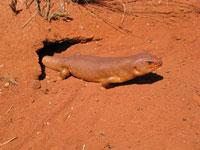The first known case of cooperative lizard living reported by Australian researchers.
Researchers Steve McAlpin, Paul Duckett and Adam Stow from Macquarie University, working in partnership with Parks Australia, have made a stunning discovery, while investigating the social nature of the great desert burrowing skink (Liopholis kintorei). This lizard inhabits the sandy plain of Central Australia, and lives in family groups.

Photo Courtesy of Adam Stow
The researchers found how these skinks work collectively to construct and maintain their complex network of burrows which can extend more than 40 feet and may have up to 20 entrances, even incorporating specifically-located latrines.
The researchers found how these skinks work collectively to construct and maintain their complex network of burrows which can extend more than 40 feet and may have up to 20 entrances, even incorporating specifically-located latrines. The faithful nature of the adult pairs, which breed together in consecutive years, helps to underpin this social structure, even though some 40 percent of males in this study had produced offspring with different females.
Unique Behavior
Out of more than 5,000 species of lizard recognized worldwide, the great desert burrowing skink is the only one that cooperates in this way to create and maintain a family dwelling. These burrows can be continuously occupied for up to seven years. Multiple generations participate in construction and maintenance of burrows, with the tunnels mostly excavated and maintained by adults, while immature lizards contribute small “pop” holes to the network.
Parental tests using DNA analysis showed that immature individuals within the same burrow were mostly full siblings, even when several different ages were present. The study, carried out in the Uluru-Kata Tjuta National Park, also revealed that all immature lizards were full siblings in 18 of 24 burrow systems.
This confirmed that offspring were therefore delaying their dispersal to stay at home. Parents were always captured at burrows containing their offspring, and females were only detected breeding with the same male both within and across seasons.
"For adults to invest so much in a home within which their kids mature, so it makes evolutionary sense that these adult individuals are sure that they are providing for their own offspring," said Adam Stow, Senior Lecturer in Biology at Macquarie University, New South Wales, Australia.
Further Questions
The construction and maintenance of a long-term family home occurs in many other taxa; in vertebrates, there are examples from most phyla. Cooperative behaviors generally occur among related individuals, but mate fidelity is not common in lizard species, and this may explain the rarity of such social behavior in these reptiles.
Future work will concentrate on the parental care that the great desert skink provides, the effort different individuals put into homemaking and the identification of lazy siblings that might be shirking their home maintenance responsibilities, and how this is managed by other group members.
Reference
Steve McAlpin, Paul Duckett, Adam Stow. Lizards Cooperatively Tunnel to Construct a Long-Term Home for Family Members. PLoS ONE, 2011; 6 (5): e19041 DOI can be found online here.



